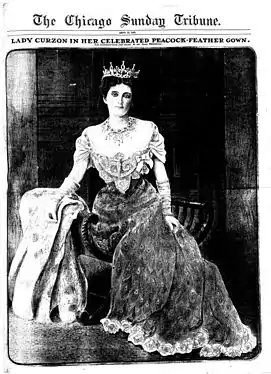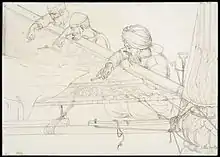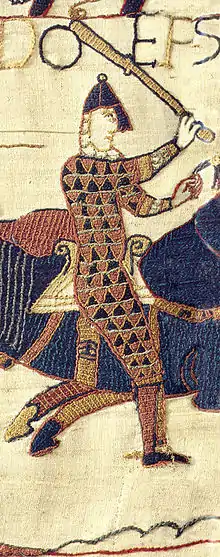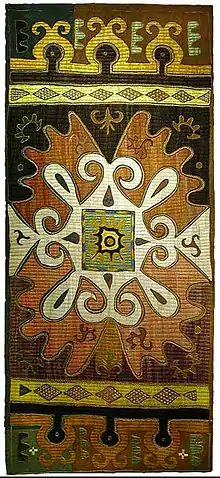Zardozi
Zardozi or Zar-douzi, also Zardosi (Persian: زَردوزی, Arabic: خرير الماء, Hindi: ज़रदोज़ी, Urdu: زَردوزی, Azerbaijani: Zərdozi, Turkish: Ters örgü), work is a type of embroidery in Iran, Azerbaijan, Iraq,[1] Kuwait, Syria, Turkey, Central Asia, India, Pakistan and Bangladesh. Zardozi comes from two Persian words: zar or zarin meaning 'gold', and dozi meaning 'sewing'.[2] Zardozi is a type of heavy and elaborate metal embroidery on a silk, satin, or velvet fabric base.[3] Designs are often created using gold and silver threads and can incorporate pearls, beads, and precious stones.[4] It is used as decoration for a wide range of applications, including clothes, household textiles, and animal trappings.[3] Historically, it was used to adorn the walls of royal tents, scabbards, wall hangings and the paraphernalia of regal elephants and horses.[5]
_Embroidery_Cushion_Covers.jpg.webp)

Initially, the embroidery was done with pure silver wires and real gold leaves. However, today, craftsmen make use of a combination of copper wire, with a golden or silver polish, and silk thread.
Indian subcontinent

Gold embroidery has existed in India since the time of the Rigveda, between 1500 and 1200 BC. It prospered during the 17th century during the reign of the Mughal emperor Akbar, but later a loss of royal patronage and industrialization led to its decline. The craft began to experience a resurgence in popularity following India's independence in 1947.[2][5]
Today, zardozi is popular in the Indian cities of Lucknow, Farrukhabad, Chennai and Bhopal.[6] In 2013, the Geographical Indication Registry (GIR) accorded Geographical Indication (GI) registration to the Lucknow zardozi. With GI status, zardozi artisans, distributors, and retailers in Lucknow and the six surrounding districts of Barabanki, Unnao, Sitapur, Rae Bareli, Hardoi and Amethi can become authorized users of the "Lucknow Zardozi" brand and carry a unique mark of authenticity.[7]
Iran
Zardozi is an important handicraft in Persian culture. It is known around the country by names such as zar-douzi (Persian: زردوزی), kam-douzi (Persian: کمدوزی), gol-douzi (Persian: گلدوزی) and kaman-douzi (Persian: کماندوزی). Nowadays it is more popular in Hormozgan, especially in Bandar-e Lenge, Bandar-e Abbas, and Minab.[8]
Persian zardozi is of three kinds:
- Some people completely sew the basic fabric with Bakhie (Persian: بخیه) in order to produce novel patterns and colors, such as the Baloch's Souzan-douzi (Persian: سوزندوزی), Rasht's Qollab-douzi (Persian: قلابدوزی) and Kerman's Pate-douzi (Persian: پَتهدوزی).
- Some sew with less density of work on the original fabric. They cross the strings throughout the woof of the fabric and sew them to each other to form a colorfully patterned lattice, such as sekke-douzi (Persian: سکّهدوزی) or qollab-douzi (Persian: قلابدوزی) in Isfahan.
- A third way is to sew a variety of patterns on the original fabric with gold and silver strings, such as Dah-Yek-Douzi (Persian: دهيکدوزی), Naqade-douzi (Persian: نقدهدوزی), Tafte-douzi (Persian: تافتهدوزی), Kous-douzi (Persian: خوسدوزی) Zari-douzi (Persian: زردوزی) or Golabatoun-douzi (Persian: گلابتوندوزی).[8]
References
- John, J.; Ghosh, Ruma (2003). Study of child labour in the Zardosi and Hathari units of Varanasi. V.V. Giri National Labour Institute. p. 13.
- Pathak, Nilima (18 July 2018). "Zardozi workers struggle to make ends meet". Gulf News. Retrieved 7 April 2019.
- Naik, Shailaja D. (1996). Traditional embroideries of India. A.P.H. Pub. Corp. p. 144. ISBN 8170247314.
- "Indian Zari Embroidery". TRC Needles. Textile Research Center. Retrieved 7 April 2019.
- Bhattacharyya, Ranadeep (1 August 2017). "Silver and Gold- Story of Zardozi". Heritage India Magazine. Retrieved 7 April 2019.
- "Zardozi". Cultural India. Retrieved 25 May 2008.
- Rawat, Virendra Singh (24 April 2013). "Lucknow zardozi gets GI registration". The Business Standard. New Delhi/Lucknow. Retrieved 10 July 2013.
- "گلابتون دوزی" [Scarabs] (in Persian). 5 February 2008. Retrieved 21 May 2011.
External links
 Media related to Zardozi at Wikimedia Commons
Media related to Zardozi at Wikimedia Commons


